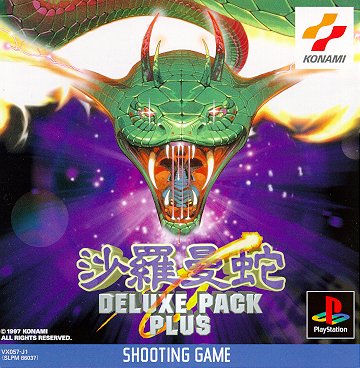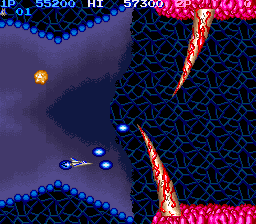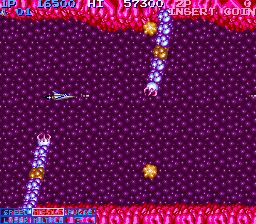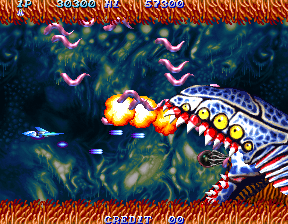Main
What's
New
Import Stores
Import Reviews
Import Cover Archive
Special Features
Games
The Top
100
Video Game Fiction
Wanted!
Acknowledgements
Forum
Links
Import Stores
Import Reviews
Import Cover Archive
Special Features
Games
The Top 100
Video Game Fiction
Wanted!
Acknowledgements
Forum
Links
The various deluxe packs that Konami released for the Sega Saturn and Sony PlayStation during the mid-90s have become quite coveted items among collectors due to their arcade-perfect ports of some of Konami's greatest shooters. None of them were released outside of Japan, aside from the Parodius Deluxe Pack which was released in Europe. The Salamander Deluxe Pack Plus is no exception - it too was released for both systems, it was never released outside of Japan, and it is quite a coveted import for either system. However, unlike the other deluxe packs which only have two games per disc, this one has three (hence the "Plus" part of the title) - Salamander, Life Force, and Salamander 2. Just so you know, the version I'm reviewing here is the PlayStation version. I have no reason to believe that the Saturn version differs all that much - I've never played it, but I've never heard anything that suggests that the two versions are different at all.
Salamander (originally released in 1986) resembles the original Gradius on the surface, just in a more organic setting. Unlike Gradius, however, Salamander can be played by two players simultaneously (along with all of the other games in the series) - player one takes control of the Vic Viper, while player two controls the RoadBritish Space Destroyer, which debuted in this game (later the RoadBritish became known as the LordBritish - according to Johnny Undaunted, in Japanese the word Lord, Road and Load are actually spelled out the same way in Japanese [ro-o-do]. Because of this, the three words are almost indistinguishable to the Japanese ears. So it's really not much of a name change as it's more of an alternate spelling). One thing is instantly noticable - the complete lack of the classic Gradius power meter. In Salamander, you actually pick up power-up icons, much like you do in just about every other shooter ever made. This presents a problem when trying to get a shield - for some reason, Konami decided that a shield icon would give you one shield that would protect only one part of your ship. These shields aren't the classic force field shields you may recall from the NES Life Force and the later Gradius games - it's the lousy shield from the original Gradius. Instead of two in front of your ship, you only get one big one on each side for each shield icon you get. Since shield icons are few and far between, don't expect to have your ship protected on all sides - ever. Since shields get worn down extremely easily, don't expect to keep the ones you do get for very long, either.
That problem aside, it's very easy to get different powerups, as several enemies drop them. Several of the classic Gradius weapons made their first appearance in Salamander - the Ripple laser, the Plutonic/Cyclone laser, and the 2-Way missiles. Salamander also marked the first appearance of a feature that, while never included in the Gradius games, was used throughout the rest of the Salamander series (and in Konami's SNES shooter Axelay as well) - alternating views for the different levels. In Salamander's case, three of the levels were sidescrolling, while the other three were overhead. Level 1 was sidescrolling, level 2 was overhead, and so on.
Life Force (originally released in 1987) looks identical to Salamander, except that just about anything mechanical has been thrown out and replaced completely by organic matierial. The reason for this is that Life Force is Salamander, just with palette swaps for some of the characters and certain enemies and items redrawn to look organic (according to the story, you're supposed to be flying through the guts of a gigantic, planet eating alien named Zelos that's going to eat planet Gradius unless you stop him. That was changed in the U.S. release to some kind of medical/surgery related story, similar to the Body Wars attraction at Disney's EPCOT Center in Florida). Besides that, there are a few small things that make Life Force almost a completely seperate game - the inclusion of the Gradius power meter, for one. This makes Life Force much easier than Salamander... the same shield problem that plagued Salamander is here, but seeing as how you can use the power meter to power up your shields, it's not as bad as it was before. Some of the music from Salamander was changed for Life Force as well - a lot of it is the same, such as the level 1, boss and ending themes, but there are some all new pieces of music as well. The graphics for both games, while almost identical, are quite good. If you're familiar with Konami's other arcade games of the time, then you know what to expect from both of these graphically.
Allow me to go slightly off topic here for a sec to settle something regarding the NES "port" of the Life Force arcade game. The NES game is almost completely different from the arcade version. So if you're expecting a better looking, yet identical version of the NES game when you play this, you may be slightly disappointed. The NES game had several bosses and levels that were exclusive to it alone, and the music in the game is a mixture of music from both the Salamander and Life Force arcade games. In a sense, much like the Famicom version of Gradius II and the SNES version of Gradius III, Life Force is a remix of the arcade game. They're both different enough from each other to warrant owning both of them.
Okay, back to the review. What's considered by most gamers to be the real treat on the disc is Salamander 2 (originally released in 1996). This game never saw the light of day in U.S. arcades, much like Gradius IV which was released only two years later. Salamander 2 dropped the Gradius power meter in favor of the original Salamander powerup system, and at the same time solved the ridiculous shield problem by giving the ship a force field when a shield powerup was picked up. An all new feature of the game was the ability to power up your weapons even more by picking up two of the same kind. For instance, the Cyclone laser would be upgraded to the Hyper laser by picking up another Cyclone laser icon. The graphics are also a tremendous improvement over both Salamander and Life Force - it's been said that they're comparable to the Saturn and PSX games of the time, and I have to agree with that. A lot of the backgrounds have an almost hand-drawn look to them, and some items and creatures look almost 3-D. On top of that, the majority of the animation in the game is extremely smooth and fluid.
Several enemies that later became staples of the Gradius series appeared in Salamander for the first time - among them the Golem (the first boss) and the Intruder (the second boss). The everpresent Moai heads are back as well, although they aren't as difficult to kill as they are in Gradius. All three games have only six levels to play through (although after the ending of each you can play through them again at a higher difficulty setting), and they all control extremely well. The Vic Viper responds perfectly to your commands, so if you slam into a wall or something, you really have no one to blame but yourself. One minor problem in Salamander 2 is that when you start the game, you're limited to one slow speed until you pick up a speed icon. At least in the first two games your default speed is manageable. It would have been nice to have the same speed in Salamander 2 to start with as you do in the others, but I digress.
The difficulty of both Salamander and Life Force is high - most rookies will get their asses handed to them in just a few minutes. You have no continues in either game, so once your lives are gone, that's it - unless you're playing a two player game, where you can actually continue up to two times. Salamander 2 would be the hardest of the three, except for one thing: you have unlimited continues. In all three games, though, whenever you die, you're resurrected in the same spot. In Salamander 2 and in the two player versions of Salamander and Life Force you continue exactly where your game ended. These two things combined does make all three games a bit easier than the much harder Gradius series. Additionally, you don't have to reset the system to choose between games - you do have the option to exit from the title screen of each game and go to one of the others. That's an extremely helpful option, which is something the earlier deluxe packs lacked. You also get to see three little SD versions of the Golem march across the screen while the next game is loading (see below).



The music in both Salamander and Life Force is typical of Konami's arcade games from the mid-80s, and isn't unpleasant to listen to at all. Most of the music will be recognizable to fans of the series (one piece in particular, the boss theme, resurfaced in both Gradius II and Gradius III [arcade only]). Salamander 2's music is made up of entirely new compositions for the most part, although in Loop 2 new versions of classic Salamander themes resurface (there's even a new version of one of the themes from Thundercross too, although I'm not sure which one it is). My personal favorite would have to be the new version of the music from Salamander's stage 3, "Planet Ratis". The new version sounds incredible - a lot more dynamic than the original, imo. Luckily Konami was nice enough to include sound tests for all three games, which contain unused and demo music as well as all the music heard in the games. That's a feature that Konami should have included in both the Gradius Deluxe Pack and Gradius Gaiden, but didn't. The sound effects in all three games are well done too - besides the usual weapon sfx, meaty explosions and organic squishing sounds, the quality of the digitized speech heard is impressive. There's quite a bit of it too, from the first "Destroy them all!" you hear in Salamander, to Giga's final words at the end of Salamander 2 - "I'll take you to hell with me!"
Salamander Deluxe Pack Plus is a worthy arcade compilation, and a fantastic addition to Konami's deluxe pack line. One thing I should mention are the absolutely gorgeous CG openings (two of them - one for Salamander and Life Force, the other for Salamander 2!) on the disc. They're almost as good as the opening of the Gradius Deluxe Pack. Also, for those of you that are familiar with the MSX version of Salamander, here's an interesting bit of trivia: the music that's heard in the opening of the MSX game was remade as the title screen music for the deluxe pack. That was a nice touch on Konami's part. While some kind of history section like those featured in the Namco Museum and Capcom Generation series would have been welcome, the lack of one doesn't detract from its quality. It's definitely my favorite out of all of the deluxe packs Konami produced for the Saturn and PSX. Here's a little historical trivia for you - if not for this game, the OPCFG wouldn't even exist. When the U.S. release of the combined Salamander Deluxe Pack Plus/Gradius Gaiden set was cancelled, I decided I wanted - in my own little way - to do something about it. I emailed Kurt Kalata of the Castlevania Dungeon about creating a site devoted to getting great unreleased Japanese games released in the U.S., and the rest is history...
- Rob

front cover


